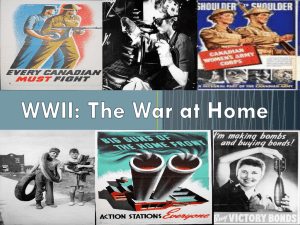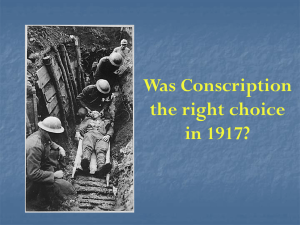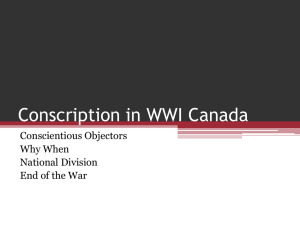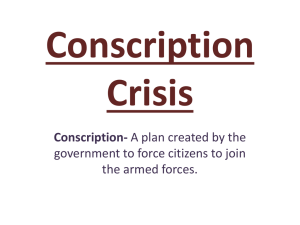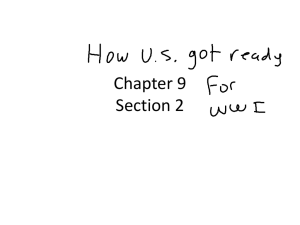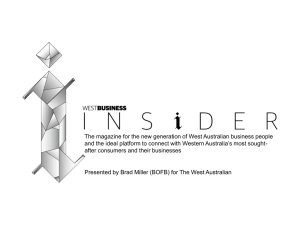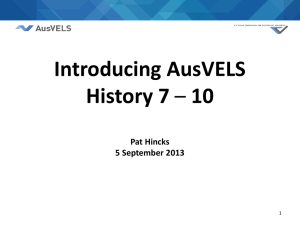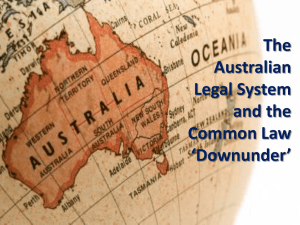Conscription
advertisement
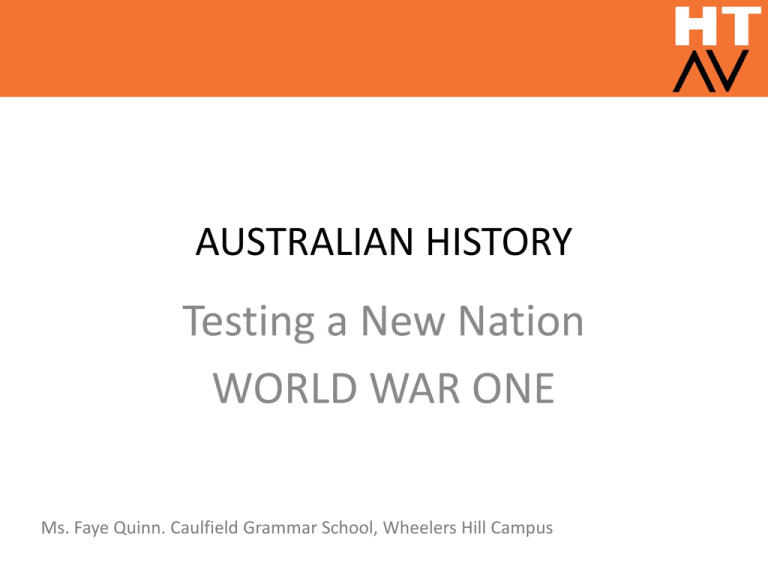
AUSTRALIAN HISTORY Testing a New Nation WORLD WAR ONE Ms. Faye Quinn. Caulfield Grammar School, Wheelers Hill Campus Key words used • • • • • • • • • • Change Redefined Pride Uncertainty Divisions United Debate Change (did/did not) National identity Galvanize Definitions • Nationalism - a devotion and loyalty to one’s own country. • Debate-a formal discussion in which opposing views are expressed. • Conscription- to military service is a system whereby the state requires all men (and in a few cases women) to serve a period in the armed forces. http://www.abc.net.au/news/2012-03-07/ww1conscription-poster/3873980 • Referendum-a vote in which all the people in a country are officially asked whether they agree with a policy or proposal. • Social Cohesion-people of the same country or region that have the same aim in sticking together or being united. • British Loyalty- a person who remains firm in their support for their particular government-British. Paragraph Relevant Evidence Analysis Introduction Conclusion Answers question Clear clear precise Essay Sharp! • How do I write an Essay? Introduction: argument. To what extent do you agree with the statement • Paragraph: 1. Topic sentence with key idea that relates to the introduction and answers the question. 2. Evidence: Content, historians views-quotes and representations. Representations (statistics, posters, poems, quotes from individuals/groups) need the name, date and an explanation of how it relates to the argument/key idea in the topic sentence. Bias/the way it has been interpreted by the author. Compare and contrast the images and accounts. How are they similar or different when contributing to the argument? • Conclusion: a strong argument. What is your overall argument? Have you responded to the essay question. A piece or two of evidence to make the overall argument strong. INTRODUCTION Topic Sentence Evidence Concluding sentence PARAGRAPH Trade Unions strongly opposed conscription during the crisis of World War I for economic reasons in 1914 and 1915. This is because if conscription went ahead the unemployment levels in society would rise and therefore cause the economy to drop, making living difficult and conditions of living poor due to the inflation of prices. ‘Economic impact of war was immediate and significant with 12,000 people in NSW losing jobs in 1914 due to the contribution to war’. This reasoning made people begin to wonder why the country was at war. In 1917, this economic focus of opposition to turned and became a class war focus. Unionists believed that conscription would be unfair and that more working class citizens would be conscripted than wealthy citizens. This caused an aggressive, uncompromising and hostile attitude emerging from unionists towards Hughes in 1917. At this time, the social unrest and economic hardship caused the largest industrial action in Australian history. This was evident in 1917 where 97,550 workers went on strike and created tensions within society, causing separation in unity. Topic Sentence Evidence Concluding Sentence The chosen crisis and ways in which Australians responded to the Crisis The chosen crisis and the ways in which Australians responded to that crisis; • To identify the crisis i.e. World War. • How did Australia become involved? Alliance with Britain, A brief explanation. • How did Australia respond in the early stages of the War? E.g. War Precautions, Gallipoli, enlistments and commitment of troops, government attitudes. http://en.wikipedia.org/wiki/History_of_the_Australian_Arm y • Why did men enlist? How does this relate to being a citizen? • How did the ANZAC legend relate to being Australian and part of a nation? Was this unifying for society? What was the impact of of the Gallipoli to enlistment numbers? http://hsc.csu.edu.au/modern_history/core_study/ww1/posters/page74.htm War Precautions Act • The War Precautions Act gave the Commonwealth Government weight in two main areas. It could make laws that were normally not within its prerogative -- so in effect the Constitution which normally limited the Commonwealth’s power was suspended for the duration of the war and six months afterwards. • The other great change was that many of these new powers available to the Commonwealth were able to be exercisable under Regulation, meaning that parliament did not have to pass the law, all it required was a document prepared by the relevant Minister, and signed by the Governor-General. www.ww1propaganda.com/ww1-poster/australiasimperishable-record-australians-empire-needs-you • So in effect parliament lost much of its control during the war, and laws were made by a few Ministers. • some of the major activities carried out under the authority of the War Precautions Act by the Commonwealth were: • passing Trading With the Enemy Acts that cancelled existing commercial contracts with firms in enemy countries; • creating loans to raise money for the war; • taking on power to tax incomes -- they shared this with the States, who previously had this power for themselves; • fixing the price of many goods -- something that the Constitution did not give the Commonwealth the prerogative to do normally; • interning (locking up) without trial people who were born in or had an association with enemy countries; • compulsorily buying farmers’ wheat and wool crops; and • censoring publications and letters. The extent to which the cohesion of Australian society maintained or redefined by the experience of the crisis • What impact did Gallipoli have on the home front within Australia? Statistics relating to enlistment, recruitment • What was conscription? • Why was it needed? How does it relate to British loyalty and Australian nationalism? • What was the impact of causalities at the Western Front (1916) in relation to enlistment numbers? • Was the experience at Western Front the turning point for the call by Hughes for conscription? • 1914-50,000 men volunteered • 1916-160,000 • 1916-British War Office requested 32,000 for September and 16,500 for each month after • Between July and November 191628,000 AIF had died, 58,000 wounded at first Battle of the Somme • 1916 July- Hughes announced a referendum based on conscription • 1917/1918 for each month only 5,000 men volunteered each month. Image:http://www.google.com.au/imgres?imgurl=http://www.w w1westernfront.gov.au/ Text: Imaging Australia Australian History VCE Units 3 & 4 by Sarah Miriams, Maryellen Davidson and Sue Gordon Billy Hughes • Who was Hughes? • Why did he want conscription? "I'll Have You" [The Prime Minister, William Morris Hughes, depicted in Claude Marquet's illustration, in the Australian Worker, 13 December 1917] What arguments were present by groups/individuals that divided society? • • • • Wobblies Farmers Women Catholics and Archbishop Mannix • Unions Archbishop Mannix www.mannix.monash.edu.au/about/history.html Wobblies • The Industrial Workers of the World (the IWW). • A political, industrial revolutionary group founded in Chicago in 1905. • Wobblies were recruited from foreign , unskilled or iterant workers who aspired to unwritten all ‘the class-conscious’ workers in ‘one big union’. • The basic belief was that the working class and the capitalist had nothing in common and that as long as millions of workers were in want, while their exploiters lived in affluence, there would be no peace between the two classes. • Wobblies placed heavy emphasis on strike action and industrial violence • The Wobblies were against the capitalists and felt that the’ war to end all wars’ was just a sordid struggle between rival groups of capitalists for the commercial and industrial supremacy of the world. • They were anti-war, anti-conscription, antiimperialist. • Conscription was for the war effort and ‘…automatically enforce industrial conscription in the workshop, the mine, the factory and on the wharf; and conscription would place military law above civil law, paralyze the biggest efforts of organized labor and lead to industrial coercion. (Baker Ann, 1983, The doctrines, activities and the character of the Industrial Workers of the World, Agora, August.) • Hughes as Labour Prime Minister wanted conscription at all costs for the war effort. • Unions began to distrust Hughes and the Labour Party. Prime Minister William Morris Hughes. http://conscriptionprojectatmacrob.blogspot .com.au/2011_05_01_archive.html • 1917 many unionists began to think less of addressing economic grievances and more of a class war. • Unionists felt that the ‘parasites, patriots were usually wealthy, Protestant and strong supporters of Hughes, the Empire and the war’. • Such conservatives viewed wartime strikes as violating the virtues of discipline, sacrifice and loyalty. Strikers were the ‘enemy within’. • As Hughes stated at the Sydney Town Hall on 4 August 1917 ‘Strikers were equally as disloyal and equally as cowardly as those Russians who dropped their arms and fled before the enemy’. • Unions had changed from being cooperative and subdued in 1914-15 to being aggressive and uncompromising by 1917. • The class argument was strong. • Conservatives whose views related to that in Europe and impatience towards the strikes and a greater sense of punishing the strikers. • 1917 2nd August, the NSW nationalist government attempted to enforce a time card system on employees at Randwick tramway workshops. • Meat workers, wharf labourers left their jobs like wildfire. • Strike involved 95,000 men. • The NSW government took a stand by recruiting volunteer labour. 6,000 loyalists workers replaced the unionists. • Governments saw the situation as ‘Servile slaves of the Kaiser’ • Strike represented politically directed warfare. • After 6 weeks the strike had been smashed and strikers had been forced to surrender unconditionally. • Therefore the strike demonstrated a disillusionment, anger, hatred towards the Hughes Government and labour. • Hence, when the referendum was put forward, there was little support by the unions for the conscription issue. (Deery P., 1989, Unions and government during the Great War, Readings in Senior History, No 10.) Women’s view • Women took an active part in recruitment campaigns throughout the war but were particularly obvious during the conscription referendum campaign. • Many of the arguments of both sides were aimed at influencing women’s vote. • Others attempted to have an active, rather than passive, influence. The campaign for women’s vote was not at first organized as it was to become in 1917. ‘Yes’ Campaign by Women Women’s Christian Temperance Union • Opposed conscription before the war but changed its attitude because of the increase in its membership i.e. middleclass women • Concerned with the issue of alcohol and believed that conscription would lessen the incidence of drunkenness. • Felt that the mothers had grit in sending in their sons to war • To address the slackers who had not volunteered • To address the issue of manhood. http://www.cafepress.com.au/+w omen_of_queensland_wwi_small _poster,575982159 ‘No’ Campaign by Women Kate Dwyer’s article ‘Women’s Part’ • ‘You wives and mothers of men, you give to the world that once taken and can never be restored-life’ • ‘…The enslavement of manhood-conscription of flesh and blood’ • You mothers will know the thrills of joy, and the delights of youth and life-and the glory of parenthood.’ • Let them (men) decide their own destinies-their innate right to a full life. http://en.wikipedia.org/wiki/ World_War_I_conscription_in_ Australia Why did the rural sector vote ‘no’ to conscription? • Fearful of the shortage of labour. • Many farmers had failed to due their duty due to mundane, practical and immediate reasons ie pressing needs for crops, shear the sheep and milk the cows in a countryside depleted by a shortage of labour. • Farmers had been destroyed by two years of voluntary enlistments. • Timing of the 1916 referendum was during the height of the agricultural season ie fruit and milking. • Hughes felt that the farmers had benefited from the war by overseas markets and the contributions to the war effort. • State and Wartime measures to protect the public by fixing the prices of essential commodities were seen as an attack on primary producers. • Expenditure cuts in the areas of public works and railways denied many country people their usual sources of off-season work. • Farmers resented government ‘interference’ especially by a ‘socialist’ government, droughts of 1913-1915 and war –induced disruptions had brought home to the farmers his doubt on relying on governments • In South Australia, where there was a higher percentage of German farmers, they voted ‘no’. They were concerned their way of life, and smarting under the suspicions and harassments of wartime, voters responded negatively at the ballot box. (Historical Studies, 1985, Farmers and the rural vote in South Australia in World War 1: The 1916 conscription referendum, Vol. 21., No. 84) The extent to which the crisis shook old certainties and provided opportunities for people to argue for change • Old certainties were shaken via the referendums 1916 and 1917 due to the divisive nature of conscription. • Insert some key results form the referendums to highlight divisive nature • People questioned why be involved in a war especially for Britain so loyalty towards Britain was challenged- argument for change • Nationalism had emerged and solidified with the ANZAC Legend. • Need quotes from Ashmead-Barlett and C.E. W. Bean. To highlight characteristics of the ANZAC Legend • Use the cover of the ANZAC Book by C.E. W. bean to highlight this. • Gallipoli was the ‘glue’ that united Australia despite the conscription issue. • Also discuss the qualities ( mateship, determination etc.) of what it meant to be Australian as a result of Gallipoli- argument for change a new, unique type of Australian- a white Australian 2005 VCAA Exam ‘The cohesion of Australian society was significantly redefined by the experience of World War I.. To what extent do you agree? 2006 VCAA Exam ‘During World War I, deep divisions in Australian society were clearly revealed and these could not be resolved.’ To what extent do you agree? 2007 VCAA Exam ‘Divisions in society virtually disappeared during the crisis of World War I. All were united in a common cause.’ To what extent do you agree? 2008 VCAA Exam ‘After a period of early unity, the crisis of World War I produced widespread debate. This resulted in a great deal of change in Australian society.’ To what extent do you agree? 2009 VCAA Exam ‘Australian society did not change significantly during World War I.’ To what extent do you agree with this statement? 2010 VCAA Exam ‘Australians responded to World War I with a mixture of pride and uncertainty.’ To what extent do you agree with this statement? 2011 VCAA Exam ‘The crisis of World War I led to the development of an Australian national identity and a move away from loyalty to the British Empire.’ To what extent do you agree with this statement? http://www.vcaa.vic.edu.au/Pages/vce/studies/history/aushistory/exams.aspx 2012 VCAA Exam ‘Debates, such as those on conscription 2012 VCAA Exam ‘Debates, such as those on conscription, indicated that deep divisions had emerged in Australian society during World War 1.’ To what extent do you agree with this statement? 2013 VCAA Exam ??????????????
